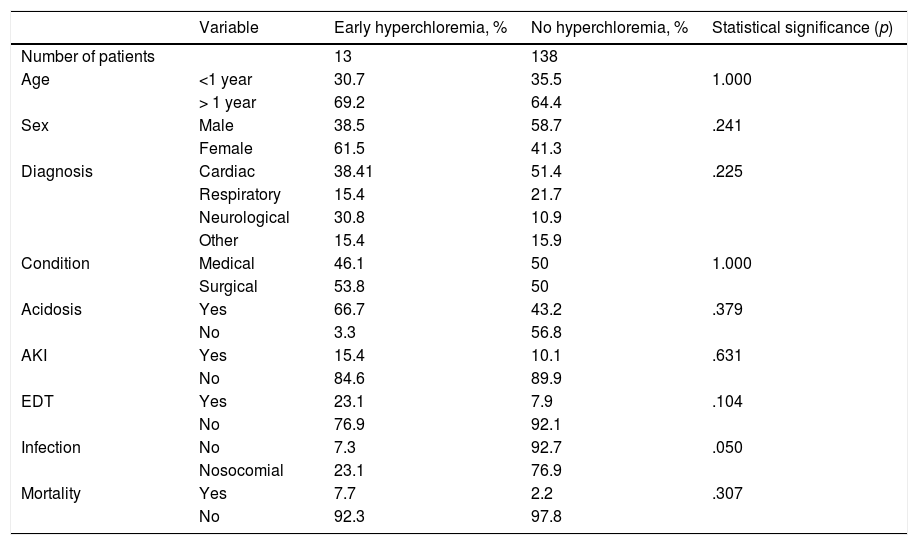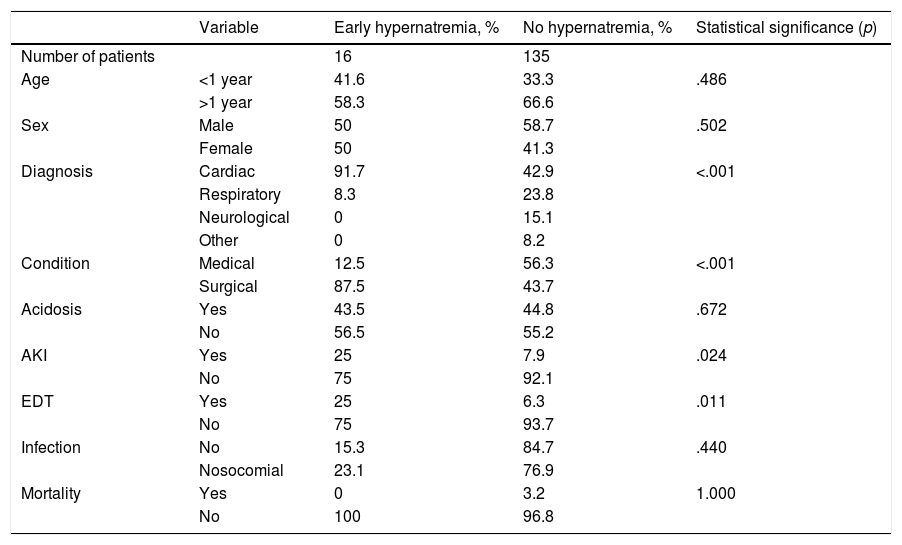Hyperchloremia and hypernatremia are relatively common alterations in critically ill children.1,2 In the adult population, hyperchloremia and sodium alterations are associated with a high mortality rate.3 However, few studies have analyzed the incidence rate and repercussions of chlorine and sodium alterations in critically ill children.1,4
A retrospective study was conducted including 250 patients hospitalized in the Pediatric Intensive Care Unit (PICU) for 7 months to study the incidence rate of early hyperchloremia and hypernatremia in critically ill children and their association with acute kidney injury (AKI) based on the pediatric criteria established by the Kidney Disease: Improving Global Outcomes (KDIGO) organization: infection (based on the diagnoses of the patient's discharge summary), and mortality. The study was approved by the center clinical research ethics committee (code 294/17). A total of 151 children with sodium and chlorine levels measured at admission were studied. The patients’ mean age was 2.3 years and the interquartile range was between 0.5 and 10.8 years.
Chlorine values between 95mEq/L and 110mEq/L, and sodium values between 135mEq/L and 145mEq/L were considered normal. Qualitative variables were compared using Fisher's exact test while the quantitative ones were compared using the Mann–Whitney U test. p values <.05 were considered statistically significant. A multivariate logistic regression analysis was conducted to analyze both the factors associated with AKI (KDIGO stage 2 or 3) and the need for extrarenal depuration techniques (EDT).
In the early blood tests performed 13 patients (8.6%) had hyperchloremia, 4 (2.6%) had hypochloremia, 24 (16%) hypernatremia, and 15 (10%) had hyponatremia. A total of 5 of these patients (33% of the total) had hyperchloremia e hypernatremia at admission. Only 1 patient had hyperchloremia >120mEq/L and hypernatremia >160mEq/L.
No statistically significant associations were reported between hyperchloremia and any of the variables studied (Table 1). Barhight et al.4 studied critically ill children and found that 56% of the patients who required EDT during admission had already had hyperchloremia at some point in the past. In our study we did not find a statistically significant association between hyperchloremia and AKI (that 16 patients did show, 10.5%) or with the need for EDT even through hyperchloremia was more common in the 13 patients who required EDT (8.6% of the total) compared to those who did not. A total of 3 (7.5%) of the 40 patients with infection at admission had hyperchloremia, 6 (6.1%) of those who did not have an infection, and 3 (21.4%) of the 13 who eventually developed a nosocomial infection (p=.019) (6 bacteremias, 4 respiratory infections, 2 surgical wound infections, 1 urinary tract infection, and 1 cellulitis). We could not explain this finding and, since the size of the sample is small, larger studies are required to confirm our data and establish whether hyperchloremia at admission is a factor that contributes to the development of nosocomial infection or is just an associated factor or an indicator associated with disease severity.
Association between early hyperchloremia and other variables.
| Variable | Early hyperchloremia, % | No hyperchloremia, % | Statistical significance (p) | |
|---|---|---|---|---|
| Number of patients | 13 | 138 | ||
| Age | <1 year | 30.7 | 35.5 | 1.000 |
| > 1 year | 69.2 | 64.4 | ||
| Sex | Male | 38.5 | 58.7 | .241 |
| Female | 61.5 | 41.3 | ||
| Diagnosis | Cardiac | 38.41 | 51.4 | .225 |
| Respiratory | 15.4 | 21.7 | ||
| Neurological | 30.8 | 10.9 | ||
| Other | 15.4 | 15.9 | ||
| Condition | Medical | 46.1 | 50 | 1.000 |
| Surgical | 53.8 | 50 | ||
| Acidosis | Yes | 66.7 | 43.2 | .379 |
| No | 3.3 | 56.8 | ||
| AKI | Yes | 15.4 | 10.1 | .631 |
| No | 84.6 | 89.9 | ||
| EDT | Yes | 23.1 | 7.9 | .104 |
| No | 76.9 | 92.1 | ||
| Infection | No | 7.3 | 92.7 | .050 |
| Nosocomial | 23.1 | 76.9 | ||
| Mortality | Yes | 7.7 | 2.2 | .307 |
| No | 92.3 | 97.8 |
AKI, acute kidney injury; EDT, extrarenal depuration technique.
Hypernatremia was significantly more common in children with heart conditions and during postoperative periods (Table 2). This is somehow logical since most patients with heart conditions were hospitalized after surgery, and at the operating room often receive significant amounts of saline solutions. An association was found between hypernatremia at admission and AKI (Table 2). A total of 6 patients with early hypernatremia (25%) developed AKI vs 7.4% of children without it. Also, an association was found between early hypernatremia and the need for EDT. Consistent with our findings, a multicenter prospective study conducted in adults confirmed the existence of sodium alterations in almost 50% of the patients who required EDT being hypernatremia more common than hyponatremia at the beginning of the EDT.5 In our study, in the logistic regression analysis, the diagnosis of heart disease, postoperative admission, and hypernatremia at admission explain 89.3% of the cases of AKI, and 90.7% of the cases requiring CEDT, p<.001. However, when the 3 factors were analyzed, only hypernatremia at admission was associated significantly with the development of AKI (p=.029), increasing risk by 4.345 times (1.158–16.299), and the need for CEDT (p=.013), increasing risk by 5.958 times (1.447–24.540). There is no such thing as a clear explanation of the association between hypernatremia and the development of AKI, although an increased osmolarity can induce renal perfusion alternations. On the contrary, the frequency of infection at admission was significantly lower in children with hypernatremia.
Association between early hypernatremia and other variables.
| Variable | Early hypernatremia, % | No hypernatremia, % | Statistical significance (p) | |
|---|---|---|---|---|
| Number of patients | 16 | 135 | ||
| Age | <1 year | 41.6 | 33.3 | .486 |
| >1 year | 58.3 | 66.6 | ||
| Sex | Male | 50 | 58.7 | .502 |
| Female | 50 | 41.3 | ||
| Diagnosis | Cardiac | 91.7 | 42.9 | <.001 |
| Respiratory | 8.3 | 23.8 | ||
| Neurological | 0 | 15.1 | ||
| Other | 0 | 8.2 | ||
| Condition | Medical | 12.5 | 56.3 | <.001 |
| Surgical | 87.5 | 43.7 | ||
| Acidosis | Yes | 43.5 | 44.8 | .672 |
| No | 56.5 | 55.2 | ||
| AKI | Yes | 25 | 7.9 | .024 |
| No | 75 | 92.1 | ||
| EDT | Yes | 25 | 6.3 | .011 |
| No | 75 | 93.7 | ||
| Infection | No | 15.3 | 84.7 | .440 |
| Nosocomial | 23.1 | 76.9 | ||
| Mortality | Yes | 0 | 3.2 | 1.000 |
| No | 100 | 96.8 |
AKI, acute kidney injury; EDT, extrarenal depuration technique.
No significant differences were seen in the incidence rate of AKI, infection or mortality between children with hypernatremia and hyperchloremia and the rest of the patients.
Several studies have found an association between hyperchloremia and mortality in critically ill children,1,4,6 although the mechanism of action is not clear to this point. In our study we did not find a statistically significant association between hyperchloremia or hypernatremia and mortality, although the number of dead patients in our study (4 patients, 2.6%) is very small.
Some of the limitations of our study are its retrospective, single-center nature, and its relatively small sample. The scores of clinical severity or other factors that can impact the infection, AKI, and mortality were not analyzed. However, it is useful as a preliminary study to plan larger multicenter, prospective trials to establish the correlation between hyperchloremia and hypernatremia at PICU admission and understand the prognosis of critically ill children.
In conclusion, between 8% and 16% of critically ill children have hyperchloremia and hypernatremia at the PICU admission. Early hyperchloremia is associated with a higher rate of nosocomial infection. Hypernatremia at admission is more common in children with heart conditions and, after surgery, it is associated with the development of AKI and with the need for EDT.
FundingThe authors declared they received no funding whatsoever to conduct this study.
Conflicts of interestNone reported.
Please cite this article as: Martínez RM, Viñas T, Manrique G, López-Herce J. Hipercloremia e hipernatremia en niños en estado crítico. Med Intensiva. 2021;45:e59–e61.







